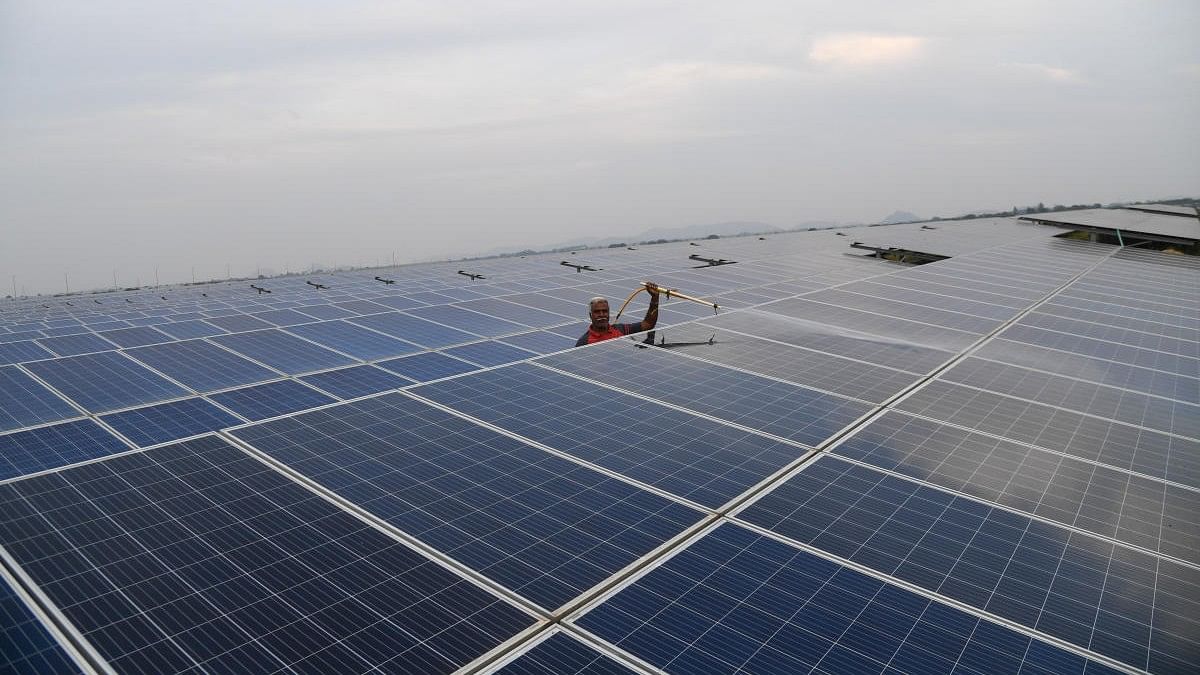
Solar park at Tirumani Village, Pavagada Taluk
Credit: DH Photo
Accelerating India’s net-zero from the previously announced target of 2070 to her 100th birthday in 2047 is a massive undertaking. It will require strong commitment from all stakeholders, all sectors, and all citizens. The platform to accelerate net zero is a three-legged stool: Government setting policies, programmes and subsidies; private industry scaling the solutions rapidly and economically; and society embracing a low-carbon lifestyle.
India brings several unique advantages to this journey. Conducive demographics supply an abundant labour force to invest in the transformation. Demographics constitute a two-edged sword. As the most populous nation, we have to seize every opportunity to grow economic activity and create high-quality jobs. We also have to be careful to encourage a low-carbon lifestyle as the middle class grows at a rapid pace.
India has the most English-speaking science, technology, engineering and mathematics (STEM) majors in the world, with nearly 50 per cent enrollment by women in colleges and advanced degrees. Its scientific prowess and entrepreneurial spirit are robust. The country boasts an advanced start-up ecosystem, evidenced by 84,000 startups, and ranks third globally in startup funding.
India is an increasingly digital society, which bodes well for customer engagement in programmes like demand/response required to balance the grid. Demand/response programmes are those in which customers
are given incentives through digital means to shift electricity
usage away from the system’s peak periods.
Compared to the rest of the developed world, India has a relatively small per capita carbon footprint of about 4 metric tons of carbon dioxide equivalent, and a unique greenhouse gas (GHG) profile dominated by the agricultural and electricity sectors. To achieve net-zero by 2047, we propose a three-phase plan:
Low-Hanging Fruit (2024 – 2030)
This phase would emphasise the agricultural and electricity sectors, as explained in earlier articles in this series. With agricultural reform, the goal would be to boost farming productivity while dramatically reducing methane emissions. Better use of resources such as seeds, water, and fertilisers would be a side-benefit.
In the power sector, a significant increase of solar, onshore and offshore wind and battery storage would be required coupled with investments in transmission and grid reliability. It is important to maximise our self-reliance while building out this ambitious electrical grid. Campaigns for electrification of transportation and cooking will begin in this period. Importantly, seeds would be planted for the subsequent two phases, especially R&D investments and startups to innovate carbon abatement methods in sectors not readily addressed by current technologies.
Gathering Momentum (2030 – 2040)
During this second phase, electricity production should achieve 100% non-carbon generation. Light-duty transportation, including 2-, 3- and 4-wheelers will achieve 100 per cent electrification, as will cooking. There will be progress on heavy-duty trucking and shipping, partial decarbonisation of manufacturing and industrial processes, and continued R&D in the hard to abate sectors such as cement, steel, aviation, shipping, mining and high-temperature industrial processes.
Mopping up (2040 – 2047)
Until 2040, the primary effort should be to scale up well-understood technologies. This phase will require new innovations, techniques, business models and startups, hence the emphasis on the necessary investment in the prior decades. Many solutions have already been proposed including smokestack capture and sequestration of carbon, use of cleanly produced “green hydrogen” as an industrial feedstock and fuel, direct air capture of GHGs from the atmosphere, electric aviation, and cargo ships with sails and electric motors. In all of these cases, economics will drive the ultimate winners and losers.
Given India’s vast resources and human power, this three-phase plan is achievable. Accelerating net zero to 2047 requires an estimated investment of $3.4 trillion, which works out to 1 per cent of India’s gross domestic product over the three phases. Of course, this effort would address the ecological and environmental climate crises. But beyond that, why should India be a leader in this space? Why should we make this massive investment? What’s in it for us? Next week, read our final article in the series to find out.
(Visweswariah is VP, cure100. org, and Muralidharan is an R&D specialist, IIT Madras. This is the sixth in a series of seven articles on the topic of climate change and net zero)